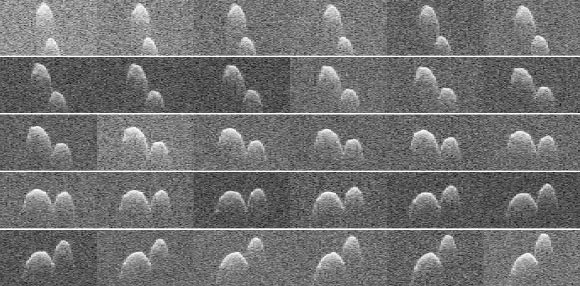Using NSF’s Green Bank Telescope in West Virginia and NASA’s Deep Space Network antenna at Goldstone, California, astronomers bounced radar signals off a passing asteroid to produce images of the peanut-shaped body as it raced past Earth July 25 at about 45,000 miles per hour. The asteroid, named 1999 JD6, appears to be a contact binary – an asteroid with two lobes that are stuck together.

This collage of radar images of 1999 JD6 was collected by NASA scientists on July 25, 2015. The asteroid appears to be a contact binary. These views, which are radar echoes, were obtained by pairing NASA’s 230-foot-wide Deep Space Network antenna at Goldstone, California, with the 330-foot Green Bank Telescope in West Virginia. Using this approach, the Goldstone antenna beams a radar signal at an asteroid and Green Bank receives the reflections. The technique, referred to as a bistatic observation, dramatically improves the amount of detail that can be seen in radar images. Image credit: NASA / JPL-Caltech / GSSR.
Asteroid 1999 JD6, otherwise known as 85989, was discovered in May 1999 by the Lowell Observatory Near-Earth-Object Search in Flagstaff, Arizona.
Its orbit swings past Earth, Venus and Mercury. Despite the uncertainty about its size, the asteroid has been studied extensively and many of its physical properties are well known.
“I’m interested in this particular asteroid because estimates of its size from previous observations – at infrared wavelengths – have not agreed. Radar data allow us to conclusively resolve the mystery of its size to better understand this interesting little world,” said Cornell University astronomer Sean Marshall.
1999 JD6 made its closest approach at 12:55 a.m. EDT on July 25 at a distance of about 4.5 million miles (7.2 million km, or about 18.6 times the distance from Earth to the Moon). The next time it will approach our planet this closely is in 2054, at approximately the same distance.
The radar data revealed the asteroid is highly elongated, with a length of around 1.2 miles (2 km) on its long axis. It rotates in just over 7.5 hours and is thought to be a relatively dark object.
“Radar imaging has shown that about 15% of near-Earth asteroids larger than 600 feet (180 m), including 1999 JD6, have this sort of lobed, peanut shape,” said Dr Lance Benner of NASA’s Jet Propulsion Laboratory in Pasadena, California, who leads NASA’s asteroid radar research program.







